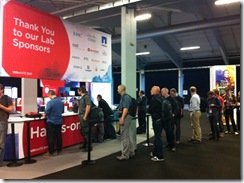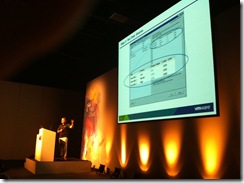VMworld Buzz: Day 2
 The VMworld train continues again today with Day 2 of the general conference. I arrived early and decided to take a lab before they get to busy and there were still quite a few people already lined up before the start at 8.
The VMworld train continues again today with Day 2 of the general conference. I arrived early and decided to take a lab before they get to busy and there were still quite a few people already lined up before the start at 8.
I decided to go for the ThinApp related lab HOL23 – Solving Application Management Challenges with Application Virtualisation as it’s not something I’ve really worked with before.
ThinApp is still virtualisation but at the application level rather than at the infrastructure level where you can package up an application and launch it from an .exe file without having to do a full install so makes it very simple to deploy packages to clients who only need access to a file share.
The first part of the lab was normal ThinApp publishing which is really similar to many other app virtualisation packages.
I was interested though in seeing how ThinApp Factory works. ThinApp factory was shown at the General Session yesterday and is an automated way to create the packages so you don’t even need to do the installation steps. There is a virtual appliance which you connect to via a web browser and set up a file share to scan. The appliance heads off and finds any app application installation files and adds them to the inventory. You can then initiate the packaging from ThinApp Factory which uses another XP VM and does the install automatically and captures the changes just like normal app packaging works, pretty slick. You can also publish feeds of applications like RSS so have a notification system for when apps are updated.
What I really liked though was the ThinApp Store which is what you would present to the end user. The end user can connect to the ThinApp Store with a web browser and install the ThinApp packages from a simple shopping cart style interface which is very simple to understand and use. This is really how you abstract the complexity of software installations for windows using a now familiar App Store interface.
Next up was the Day 2 General session presented by VMware’s Raghu Raghuram.
I then attended VSP1933 — Storage I/O Control for Networking-Attached Storage Datastores – Ajay Gulati
 Ajay went through a lot of the technical aspects of SIOC for NFS storage which is new with vSphere 5. Basically SIOC does performance isolation and is smart about it, technically that means it carves out NFS array queues among VMs. SIOC detects congestion by looking at latency on your storage network, If there is latency above a particular threshold which you can configure (default is 30ms) SIOC kicks in and throttled bandwidth to particular VMs to ensure everyone is playing nicely. It is smart because it can recycle queue slots really and with a stats collection time of each 4 seconds it has very up to date information with which to make decisions.
Ajay went through a lot of the technical aspects of SIOC for NFS storage which is new with vSphere 5. Basically SIOC does performance isolation and is smart about it, technically that means it carves out NFS array queues among VMs. SIOC detects congestion by looking at latency on your storage network, If there is latency above a particular threshold which you can configure (default is 30ms) SIOC kicks in and throttled bandwidth to particular VMs to ensure everyone is playing nicely. It is smart because it can recycle queue slots really and with a stats collection time of each 4 seconds it has very up to date information with which to make decisions.
Ajay then went through some case studies showing the effect of SIOC.
He then listed some best practices:
- Avoid different settings and use the same comparable share values for different datastores that back onto the same underlying storage resources (pools of disks).
- Avoid external access to the datastores (say from other hosts/hypervisors/LUNs etc.) that SIOC wouldn’t be able to understand. There is an alarm that will check for interference but for SIOC to work properly it should have full control.
- There are some suggested threshold values for certain disk types
- SSD 10-15 ms
- FC/SAS 20-40ms
- SATA 30-50ms
- Auto-tiered storage with full LUN – Use SAN vendor recommendation or use the value for the slowest storage.
- Auto-tiered storage with block level. Use SAN vendor recommendation or work out the ratio of fast/slow/cache and build a model yourself.
- SIOC interoperates very well with Storage DRS. Having both provides the per datastore performance isolation and across datastore load-balancing. Enabling Storage DRS will automatically enable SIOC across all datastores in the datastore cluster.
Next up I attended VSP3205 — Technology Preview: VMware vStorage APIs for VM and Application Granular Data – Satyam Vaghani, Vijay Ramachandran which was rumoured to be a all about what’s coming up for storage. There was so much information it was worth another post, VMworld Buzz: VMware’s game changer for storage
I then had lunch with Rotem Agmon, a VMware Technical Consultant at HP and we talked all about HP and Flex-10 so hopefully when I have some breathing space I will be able to blog some more info.
Next up was another great session by the gurus of HA and DRS, Duncan Epping and Frank Denneman, VSP1682 — VMware vSphere Clustering Q&A which was entirely interactive so audience participation was mandatory. They answered a whole lot of questions about all aspects of VMware clustering which includes HA, DRS & Storage clustering They were really good, amazing to be able to think on their feet and answer the most arcane of questions. I was lucky to be given a signed copy of their book for asking a question although I certainly wasn’t able to stump them at all!
I was meant to attend LAS4010 — The Hybrid Cloud for Infrastructure but didn’t get enough time so went to the solutions exchange to see what he vendors are up to which will need to be covered separately.


Thanks for attending and the great compliments and nice meeting you!